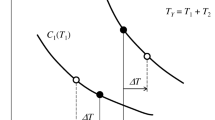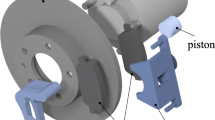Abstract
The tolerance design problem involves optimizing component and assembly tolerances to minimize the total cost (sum of manufacturing cost and quality loss). Previous literature recommended using traditional response surface methodology (RSM) designs, models, and optimization techniques to solve the tolerance design problem for the worst-case scenario in which the assembly characteristic is the sum of the component characteristics. In this article, component-amount (CA) and mixture-amount (MA) experiment approaches are proposed as more appropriate for solving this class of tolerance design problems. The CA and MA approaches are typically used for product formulation problems, but can also be applied to this type of tolerance design problem. The advantages of the CA and MA approaches over the RSM approach and over the standard, worst-case tolerance-design method are explained. Reasons for choosing between the CA and MA approaches are also discussed. The CA and MA approaches (experimental design, response modeling, and optimization) are illustrated using real examples.
Similar content being viewed by others
References
Kim JK, Chou RC (2000) The use of response surface designs in the selection of optimum tolerance allocation. Qual Eng 13:35–42
Creveling CM (1996) Tolerance design: a handbook for developing optimal specifications. Addison Wesley Longman, Reading
Şehirlioğlu AK, Özler C (2008) The use of mixture experiments in tolerance allocation problems. Int J Adv Manuf Technol 35:769–777
Jeang A (1997) An approach of tolerance design for quality improvement and cost reduction. Int J Prod Res 35:1193–1211
Jeang A (1999) Robust tolerance design by response surface methodology. Int J Adv Manuf Technol 15:399–403
Cho BR, Kim YJ, Kimber DL, Phillips MD (2000) An integrated joint optimization procedure for robust and tolerance design. Int J Prod Res 38:2309–2325
Govindaluri MS, Shin S, Cho BR (2004) Tolerance optimization using Lampert W function: an empirical approach. Int J Prod Res 42:3235–3251
Hsieh KL (2006) The study of cost-tolerance model by incorporating process capability index into product lifecycle cost. Int J Adv Manuf Technol 28:638–642
Huang MF, Zhong YR, Xu ZG (2005) Concurrent process tolerance design based on minimum product manufacturing cost and loss. Int J Adv Manuf Technol 25:714–722
Jeang A (1994) Tolerance design: choose optimal specifications in the design of machined parts. Qual Reliabil Eng Int 10:27–35
Jeang A (1995) Economic tolerance design for quality. Qual Reliabil Eng Int 11:113–121
Jeang A, Chang CL (2002) Concurrent optimisation of parameter and tolerance design via computer simulation and statistical method. Int J Adv Manuf Technol 19:432–441
Jeang A, Leu E (1999) Robust tolerance design by computer experiment. Int J Prod Res 37:1949–1961
Liao MY (2010) Economic tolerance design for folded normal data. Int J Prod Res 48:4123–4137
Mao J, Cao YL, Liu SQ, Yang JX (2009) Manufacturing environment-oriented robust tolerance optimization method. Int J Adv Manuf Technol 41:57–65
Moskowitz H, Plante R, Duffy J (2001) Multivariate tolerance design using quality loss. IIE Transact 33:437–448
Muthu P, Dhanalakshmi V, Sankaranarayanasamy K (2009) Optimal tolerance design of assembly for minimum quality loss and manufacturing cost using metaheuristic algorithms. Int J Adv Manuf Technol 44:1154–1164
Peng HP, Jiang XQ, Xu ZG, Liu XJ (2008) Optimal tolerance design for products with correlated characteristics by considering the present worth of quality loss. Int J Adv Manuf Technol 39:1–8
Shin S, Kongsuwon P, Cho BR (2010) Development of the parametric tolerance modeling and optimization schemes and cost-effective solutions. Eur J Oper Res 207:1728–1741
Tang K (1988) Economic design of a two-sided screening procedure using a correlated variable. Appl Stat 37:231–241
Wu CC, Chen Z, Tang GR (1998) Component tolerance design for minimum quality loss and manufacturing cost. Comp in Indust 35:223–232
Wu CC, Tang GR (1998) Tolerance design for products with asymmetric quality losses. Int J Prod Res 36:2529–2541
Box GEP, Draper NR (1987) Empirical model building and response surfaces. Wiley, New York
Khuri AI, Cornell JA (1996) Response surfaces: designs and analyses, 2nd edn. Marcel Dekker, New York
Myers RH, Montgomery DC, Anderson-Cook CM (2009) Response surface methodology—process and product optimization using designed experiments, 3rd edn. Wiley, New York
Scheffé H (1958) Experiments with mixtures. J Royal Statist, Soc, Series B 20:344–360
Cornell JA (2002) Experiments with mixtures, 3rd edn. Wiley, New York
Smith WJ (2005) Experimental design for formulation. Society for Industrial and Applied Mathematics, Philadelphia
Piepel GF, Cornell JA (1987) Designs for mixture-amount experiments. J Qual Technol 19:11–28
Piepel GF, Cornell JA (1985) Models for mixture experiments when the response depends on the total amount. Technometrics 27:219–227
Atkinson A, Donev A, Tobias R (2007) Optimum experimental designs, with SAS. Oxford University Press, Oxford
Stat-Ease (2010) Design-Expert version 8. Stat-Ease, Inc., Minneapolis
JMP (2011) JMP version 9. SAS Inc., Cary
SAS (2008) SAS version 9.2. SAS Inc., Cary
Minitab (2010) Minitab version 16. Minitab, Inc., State College
Piepel GF, Cornell JA (1986) A comparison of mixture-amount and component amount experiments, BN-SA-2179, Rev. 1. Battelle. Pacific Northwest Laboratories, Richland, Washington
Taguchi G (1989) Introduction to quality engineering. Asian Productivity Organization, Unipub, White Plains, New York
Ross PJ (1996) Taguchi techniques for quality engineering. McGraw-Hill, New York
Zhang J, Li SP, Bao NS, Zhang GJ, Xue DY, Gu PH (2010) A robust design approach to determination of tolerances of mechanical products. CIRP Annals–Manuf Technol 59:195–198
Author information
Authors and Affiliations
Corresponding author
Rights and permissions
About this article
Cite this article
Piepel, G.F., Özler, C. & Şehirlioğlu, A.K. Optimum tolerance design using component-amount and mixture-amount experiments. Int J Adv Manuf Technol 68, 2359–2369 (2013). https://doi.org/10.1007/s00170-013-4844-x
Received:
Accepted:
Published:
Issue Date:
DOI: https://doi.org/10.1007/s00170-013-4844-x




